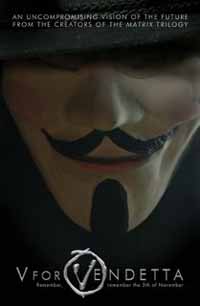Friday, March 24, 2006
V for Really Great
By Josh Lamkin Okay, I don't often get excited about movies. I mean, I don't have a ton of cash to throw at every Ben Stiller movie that comes out (that's a shitload of movies), even though I'd like to. So when I do get excited about a movie and actually buy a ticket and don't sneak in by walking backwards through the exit doors while people are leaving the theater (this really does work, by the way), it fucking better be good.
Okay, I don't often get excited about movies. I mean, I don't have a ton of cash to throw at every Ben Stiller movie that comes out (that's a shitload of movies), even though I'd like to. So when I do get excited about a movie and actually buy a ticket and don't sneak in by walking backwards through the exit doors while people are leaving the theater (this really does work, by the way), it fucking better be good.I'm not a movie snob. I like everything from idiot comedies to art house stuff, heartwrenching dramas to thrillers to chick flicks, hell even the Jackass! movie. For some reason I was excited about V for Vendetta. It was probably the cred that the Wachowski brothers bring to whatever they do. I mean, those guys could do a biopic about Mother Theresa and I'd go see it for the kickass action scenes and special effects. I was excited about V for Vendetta and it didn't disappoint.
We saw V for Vendetta at a brand new theater with great new seats and a sound system that was only a few decibels softer than a Quiet Riot concert. If you're gonna see an action-thriller movie, you gotta do it like that. The movie was kickass. I knew I was going to love this movie in the first five minutes of the film when we meet Codename V and he recites a three minute monologue in which virtually every word begins with the letter V, and I think he used every word in the English language that starts with V except maybe vagina. Anyway, there was a great visual style to the film as well, and I particularly noticed the use of the color red as the color that both the "good" and "bad" guys used in their respective symbols. I liked the way using the same color for both sides blurred the line between good/evil, and that's an important point the film makes over and over.
Vendetta is constantly on the offensive with barely veiled assaults on the idea of a controlling, paranoid, dishonest, racist, homophobic, and violent government. An interesting note: although the government depicted in V for Vendetta was originally intended to represent the Margaret Thatcher administration of 1980's England, it is almost impossible to miss the references to the current Bush administration (there is even a poster on the wall in Dietrich's secret room of a combination British/American/Nazi flag with the phrase "Coalition Of The Willing" on it, a phrase invoked by President Bush as he sought to shore up support for his anti-terrorist policies immediately after the attacks of 9/11/2001).
Overall, I found myself constantly surprised and even pleasantly uncomfortable witnessing the intensely subversive message of V for Vendetta. I thought it was gutsy and effective to use a variation of the crucifix for the government's symbol. The use of the Guy Fawkes theme is such a strong tacit assault on the Catholic church, I can't believe there weren't more people shitting bricks about this movie before it came out. (In case you don't know what I'm talking about, read the traditional Guy Fawkes Day verse which is still widely recited aloud on Guy Fawkes Day.) There were obvious parallels drawn between the government in this film and that of the Nazis: the ruthless government henchmen, the imprisonment of so-called dissidents or undesirables, the charismatic supreme leader. Yet perhaps most effective is the twisting around of our notions of what Terrorism and Terrorist really mean. Are they relative terms? After all, the hero in this movie is constantly and unapologetically referred to as a terrorist, and both the hero and the bad guys deliberately and coldly murder lots of people throughout the film.
In the end, It's great to see a movie that takes a few chances and assumes some intelligence of its audience. I mean, I'm not sure it's right about most of its audience's intelligence level, but it's still nice to see it. Also, Natalie Portman is hot.


0 Comments:
Post a Comment
<< Home